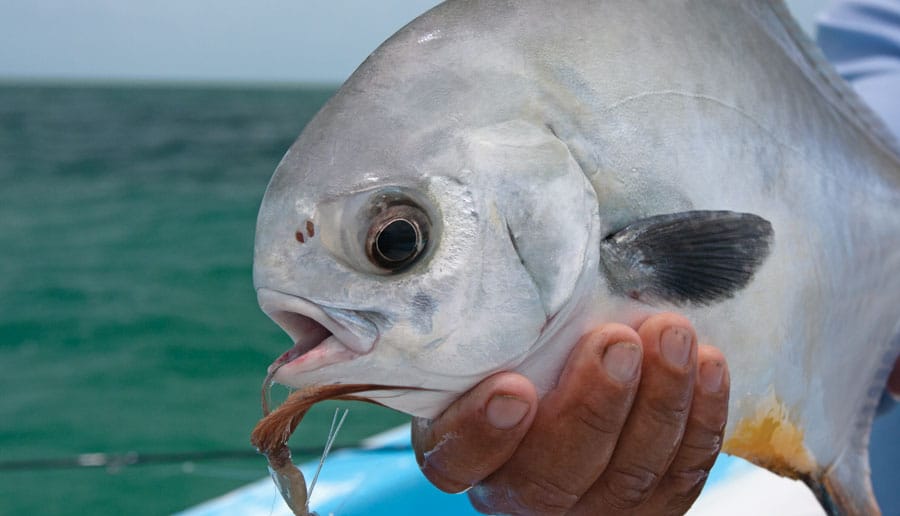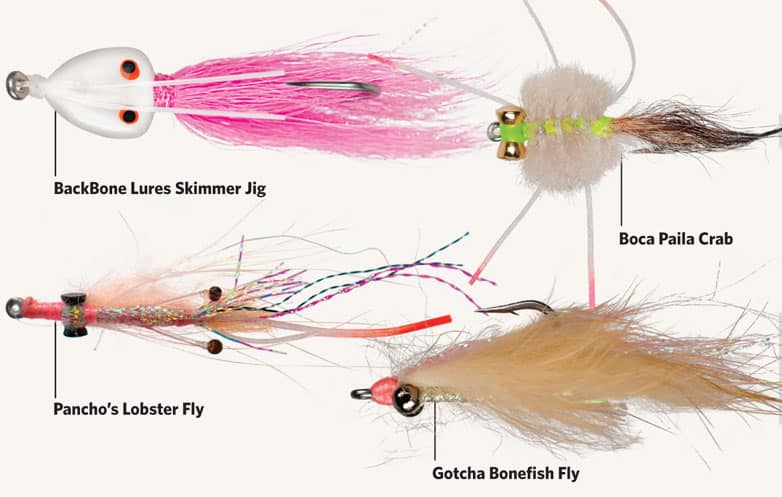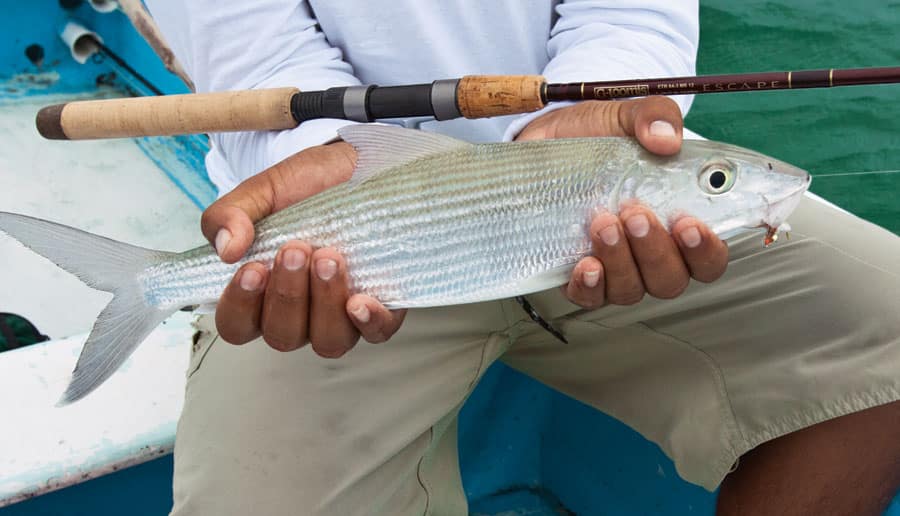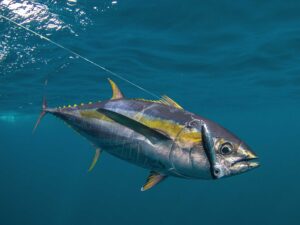
Trophy Fare
Tucked into a lee just a long backcast from the mangrove shoreline, I blind-cast into four feet of water along the edge of a rocky ledge. The skunk was already off the boat. A couple of bonefish had fallen for a skimmer jig on a light spinning rod, so I now upped the ante, casting a little shrimp fly. My guide, Pancho, on the poling platform, kept the angles right — the wind, the boat and the casting — as I let the fly sink. Balancing a bouncy little retrieve with keeping the fly on the bottom made things sporty, which I welcomed, since sight-fishing was not a possibility right then.
When slight resistance on the fly line telegraphed the take, I stripped long once, twice, and felt the hook take hold. The strength of the first run told me I was into a specimen a little huskier than the previous 3-pounders we’d landed on the jig. A couple of runs into the fight, I had the fish nearly at boat-side when it made a sudden lunge — we watched the flash of silver in the turbid water, then another flash as the line went slack. “Permit,” said Pancho. “Barracuda ate it. Did you feel the difference in that fish?” It didn’t matter if I felt the difference or not; a fly-caught permit is no small thing, and too soon it was gone.
Against the Odds
Every lost fish hurts, but if ever there were a place to lose one and later redeem yourself, it’s Mexico’s Yucatan Peninsula. The location of Pesca Maya, one of the premier flats-fishing lodges on Ascension Bay, among thousands of acres of prime flats-fishing country, makes the lost fish a little easier to take.
Ascension Bay lies in a particularly exposed portion of Mexico, at the gateway to the Gulf, entirely within the Sian Ka’an Biosphere Reserve. Sian ka’an is Maya for “gift from the sky,” and that’s precisely what we needed. A series of tropical depressions was lined up to march across the Yucatan during my stay. The salvation here is that to the north and south of the mouth of the bay, an extensive lagoon and expanse of mangrove tidal flats provide tens of square miles of protected water. Over the three days I fished, we needed that protection.
The wind pushed the tide high into the mangroves, and while we worked streamers as deep into the prop roots as we dared, the snook stayed in hiding. Other anglers at the lodge found permit schooled over bottom structure in the bay, and nearly everyone found bonefish. Particularly picky bonefish, given their average size of under 6 pounds.
The protected flats of Pinocho (Spanish for Pinocchio, a one-time resident of the sand spit that adjoins the flats, who was known, and nicknamed, for his oversize schnoz) are reminiscent of the vast flats in the Bahamas. The fish were not large and they were not numerous, but in an hour of wading, seldom were we without at least a tailing fish to stalk or attempt to intercept.
These bonefish were nobody’s fool. Their trophy quality was in their wariness, if not their size. In water just over ankle deep, the fish slipped across the flats without a ripple or a tell. Only when they stopped to tail briefly among the spiky mangrove shoots did they show themselves. A poor cast, a line passing overhead or any unnatural action on the fly sent them scooting for safety, or they simply vanished. It was challenging fishing, but with a couple of effective fly changes and careful stalking of the immense flats, we managed to bring four fish to hand for release. It was bonefish hunting at its best.
A Brief Gift
A perusal of the satellite weather that evening promised a cloudy morning, but it looked as though there might be a brief weather window in the afternoon. Perhaps we’d get a look at Ascension Bay — something I had been dreaming of for years. “It’s going to be rough crossing the mouth of the bay,” said Pancho late the next morning, after the clouds cleared. The guides in Mexico are notoriously considerate. If you express a preference, you can expect it to be honored. Seldom will they attempt to second-guess your wishes. This can be a problem if you are accustomed to relying on a guide for judgment. You have to be prepared to make decisions and assert your wishes.
The sky looked clear to the east, and while the wind was brisk, it wasn’t any worse than on a lot of days on Biscayne Bay, in Miami, or in the Florida Keys. “I want to see the bay,” I said. “You’re a good driver. If you feel safe, then I’m comfortable. Let’s go.”
**
Ascension Bay**
It was the right call. As we broke out behind the point south of Punta Allen, the waves of the Caribbean Sea came sweeping under us. The steady march of 4-footers on the beam made for a wet and sporty ride, but this wasn’t anything any of us hadn’t done plenty of times before. And it sure wasn’t worth hanging back to avoid the crossing.
Twenty wet minutes later, we were puttering over some of the cleanest, most lush turtle-grass flats imaginable, the waves flattened by the shoal a mile and a half to the east, and all was well in the world of flats-fishing.
We checked the usual outside spots for tarpon, but the tide was too low to suit Pancho. I wanted permit, and the tide was right for that. “We want an outgoing tide for the blue hole,” he explained. It was the first I had heard of a blue hole.
We motored into the bay behind the sheltering band of islands at the eastern edge and anchored upwind of a visible dark spot on the bottom. A bona fide blue hole, a subterranean cavern in the limestone floor of the bay that connected to who knows what. As Pancho explained, the wash of nutrients and other material carried out of the depths of the blue hole by the outgoing tide put the permit on the feed.
As we anchored up, we saw the occasional permit circling the blue hole, rising to within a few feet of the surface and dipping down again. I rigged a skimmer jig on 12-pound mono spooled over 40-pound PowerPro backing on a spinning outfit, and sweetened it with a piece of crab. Once the jig was on the bottom, I hopped it at the edge of the blue hole, but not for long. The bend in the rod and the way the line peeled off the spool despite a hefty helping of drag had the never familiar enough feel of permit. Shortly thereafter, the spunky little fish came aboard for a quick picture and a release.
Denial of Trophy
“The big ones will cut you off on the edge of the hole,” Pancho explained as I rerigged. “I’ve lost a lot of big permit that way.” As if on cue, the next strike was a doozy. I palmed the spool as the mono stretched and the drag chattered, but I couldn’t get the fish turned. For a minute I thought I might have a chance, but it bore down and headed into the hole, and the line went slack. I was sawed off at the 60-pound fluoro leader.
Off came the gloves. Pancho rerigged by stripping off my leader and monofilament down to the 40-pound PowerPro and knotted that directly to the hook. This did the job, but the next two fish were nothing compared to the one that got away. Time to up the game.
While I stowed the spinning gear, Pancho stripped line off my fly rod. “Let me show you how to retrieve it,” he said. I should have taken the rod away from him right then. A pair of permit crossed right to left 45 feet away downwind of him. He dropped the crab fly in front of the pair, and one of them shot forward and ate. It was a great catch, and the last permit we saw that morning, though I plied the same water for another half an hour.
Making a Move
As the tide ran out, we stopped and checked the outside of the islands at the mouth of the bay for tarpon, but the wind had things so roiled they were not around. Ordinarily you fish them on foot, wading waist deep as you cast into the mangroves. But it was not to be this trip.
Offshore we saw black clouds massing, heading our way. Our weather window was about to close.
As the sky giveth, so can it taketh away in this part of the world. We piled into the panga and headed north. We’d been running less than five minutes when the storm closed in, and the sunny shoreline disappeared behind black clouds and driving rain. Grateful for the brief gift, I was already thinking about a return trip.
TRIP PLANNER
Ascension Bay is often acknowledged as the best spot on the planet for a flats grand slam — bonefish, permit and tarpon on the same day, or the same trip. Add snook for a fourth species, and it doesn’t get any better. On spinning or fly tackle, the opportunity here is huge. Flats-fishing is never easy, but the number of shots you’ll get here will stack the odds as far in your favor as you’ll ever find them.
Pesca Maya lodge, established in 1996, is 90 miles south of Cancun and can accommodate 22 anglers. Three buildings hold 11 rooms, all with air conditioning and private bathrooms with walk-in showers. Situated on a strip of barrier beach, the lodge faces the Caribbean Sea, and the barrier reef that stretches from north of Cancun to southern Belize runs within swimming distance offshore. On the western side lies the vast El Rio system of protected flats, channels and mangroves.
Fishing is done from a fleet of 12 pangas, each manned by a guide and an assistant. Pesca Maya regularly brings in captains from the southern United States to familiarize the guiding staff with current gear and techniques. The majority of the guides in the area, at all lodges, were trained by American captains at Pesca Maya. They’re a sharp crew.
What: Bonefish, permit, tarpon and snook.
When: Year-round.
Where: The Caribbean flats and back bays of Mexico’s Yucatan Peninsula at Ascension Bay.
Who: Pesca Maya
888-894-5642
www.pescamaya.com
Rods: For fly-fishing: 9-foot 6- to 8-weight for bonefish, 8- to 10-weight for permit and tarpon, 71/2- or 8-foot 10-weight for snook in the mangroves. For spinning: 7- to 71/2-foot 8-pound-class for bonefish, 12- to 20-pound for general casting.
Reels: To match.
Lines: For fly-fishing: floating or intermediate 6- to 10-weight. For spinning: 12-pound mono for most purposes, with 30- or 40-pound braid as a backup for mangroves and blue holes.
Lures: 1/8- to 1/2-ounce skimmer jigs in brown, white and pink, such as those in the Yucatan collection by BackBone Lures (backbonelures.com), or equivalent.
Flies: Bonefish: Gotcha, Bonefish Scampi, Yucatan Special and Baby Lobster flies; permit: crab flies; tarpon and snook: black, green, yellow, white and red streamer flies, assorted poppers. My guide used an orange permanent marker to put bands on the wing material of every bonefish fly I fished.Think lobster.
Other: The lodge has a surprisingly large selection of tackle for sale and fly rods to loan, but you should still bring everything you think you’ll need, such as 30- to 60-pound fluorocarbon leader, extra mono, braid, leaders and tippet. Bring what you need to cover yourself, and expect to leave what’s left over for the guides. They greatly appreciate what to us seems common and easy to get.

Trophy Fare


Contingency Plan











